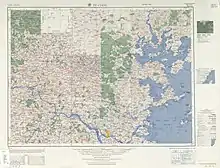Pei-kan
See also: Peikan
English

Map including 北竿塘 PEI-KAN-T'ANG (ISLAND) (AMS, 1954)
Etymology
From Mandarin 北竿 (Běigān), Wade–Giles romanization: Pei³-kan¹.
Proper noun
Pei-kan
- Alternative form of Beigan (island)
- 1970, Ken Fitzgerald, “Asia”, in The Space Age Photographic Atlas, Crown Publishers, →LCCN, →OCLC, page 196:
- South of Hang-chou Wan (Bay) below Shanghai, the China coastline changes from a smooth, flat topography to one of irregular, rocky promontories and numerous islands. Foochow, the Fugiu of Marco Polo, dates from the seventh century. Offshore the Ma-tsu Lieh-tao (Matsu and Pei-kan, or Changshu[sic – meaning Changhsu] Islands) are heavily fortified Nationalist strongholds.
- 1998, “Matsu”, in Saul B. Cohen, editor, The Columbia Gazetteer of the World, volume 2, New York: Columbia University Press, →ISBN, →LCCN, →OCLC, page 1917, column 3:
- The major isls. include Pei-kan and Nan-kan (Mazu). Fishing is the main economic activity.
- 2000, Humphrey Hawksley, Dragon Fire, Macmillan Publishers, →ISBN, →OCLC, page 315:
- 'We have successfully taken Pei-kan,' said Leung. 'Heavy shelling has been going for twenty minutes from Kinmen.
- For more quotations using this term, see Citations:Pei-kan.
Translations
Beigan — see Beigan
This article is issued from Wiktionary. The text is licensed under Creative Commons - Attribution - Sharealike. Additional terms may apply for the media files.